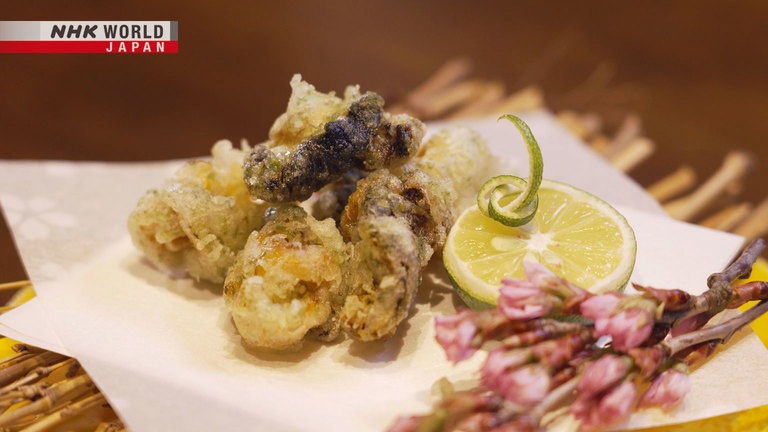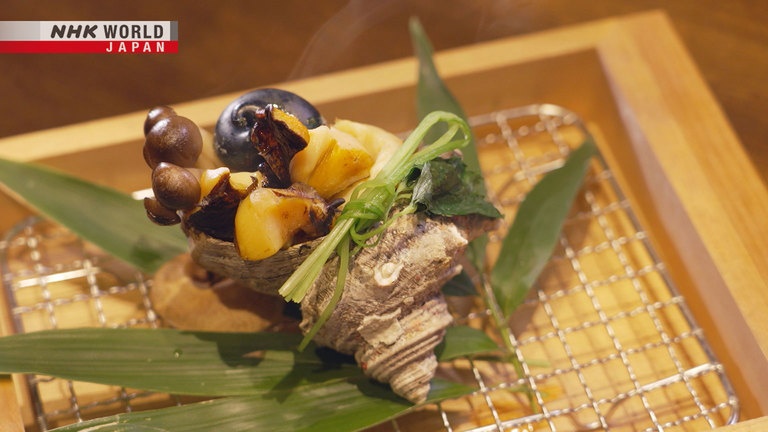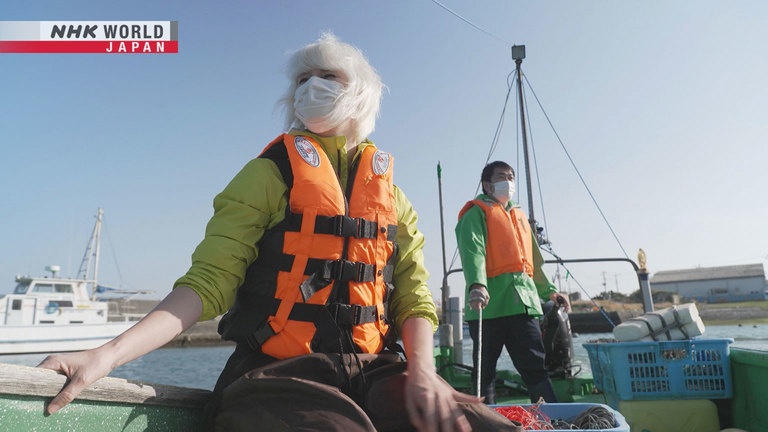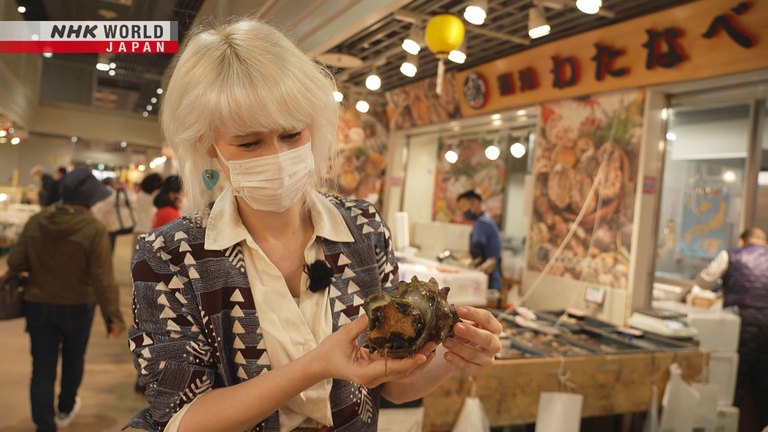SAZAE
We focus on sazae, or turban shell sea snails. Japan is no stranger to shellfish, but consumption of sazae dates back millennia. Their appearance is distinguished by shells with jagged horns. Along with meat that packs a light sweetness and satisfying crunch, their slightly bitter innards are also favored. Sazae are commonly eaten as sashimi or grilled tsuboyaki-style. They're rich in protein and vitamins and are a great source of taurine. Dive in to learn more about this peculiar sea snail. (Reporter: Saskia Thoelen)




Transcript
Tokyo: this world-class metropolis is a veritable gourmet wonderland.
Discover the stories behind the ingredients that make this city so delicious - so "oishii."
Our theme is "sazae," a sea snail known as the horned turban shell that's been eaten in Japan since ancient times.
Ones collected in spring are rich in umami and nutrients.
Prized for their chewy, slightly-sweet interior and mildly-bitter innards, sazae maintain a strong sea aroma whether eaten raw, as sashimi, or cooked.
Wow! So many!
There's so much. Whoa!
Rich in protein, vitamins and minerals, they're also one of the best sources of taurine, an umami compound found in seafood.
"Oishii!"
Discover mouth-watering charms hidden within a rugged shell.
Trails to Oishii Tokyo.
Hi. I'm Saskia from Belgium.
Today's theme will be "sazae," a type of shellfish that has been loved by Japanese since ancient times.
And even though I've been living in Japan for about seven years now, I must say that I've never eaten nor seen sazae in real life.
So, I'm really curious to see what type of shellfish it is.
Let's find out.
Tsukiji Outer Market has over 400 specialty shops selling anything from fish, veggies, fruits to processed goods.
Saskia heads to a particular section of the market.
Well, there's a lot of shellfish over there.
Wow.
There's so many pieces of shellfish.
I haven't seen them at all in Belgium.
Wow.
As an island nation, Japan is no stranger to shellfish.
They've been a key part of Japanese cuisine for millennia.
This wholesaler, well-known for its quality selection, has been dealing mainly in shellfish in Tokyo for many years.
Hello. Which are sazae?
- Sazae?
- Yeah.
These here.
- Can I have a look?
- Please.
They're big.
Around the size of a fist, the shells of sazae are distinguished by their jagged horns.
At the opening, a hard circle guards what's hiding inside.
Shell mounds dating back to the Jomon period suggest that domestic consumption goes back around 10,000 years.
We have bigger ones too.
So big.
Oh! It came out!
Of course. It's alive!
It's like a huge snail.
Wow!
It fills the entire shell?
Yes, but the main body is small.
Not the length of the shell?
Well, the innards are at
the base of the shell.
You can eat those too.
In a sweet and savory stew,
or raw as sashimi.
Where are sazae found?
Usually in reef zones.
They attach to rocks.
It's hard to see, but
the mouth is here.
They eat by scraping algae and
seaweed off rocks with their teeth.
- Do they move around?
- Slowly, yes. Like a snail.
In East Asian waters, between South Korea and Kyushu, all the way up to southern Hokkaido, sazae live in reefs up to 30 meters deep.
Their horns allow them to stand firm against a strong tide.
Which looks more like sazae to you?
More like sazae?
- This is my first time, so I have no idea.
- Which looks cooler?
- Well, this one.
- Right?
The ones with larger horns are better.
They live in rougher waters,
so they're packed with tasty meat.
- They get more muscle?
- Exactly.
I can't help but wonder how something like this is eaten.
Saskia heads to a shellfish restaurant near the market.
- Hello.
- Welcome.
- Thank you for having me.
- My pleasure.
Fujinami Kazuya is trained in traditional multi-course cuisine called "kaiseki-ryori."
Sashimi is up first.
Removing the hard top, he pulls out the raw interior.
Overly bitter and slimy parts are removed first.
The firm meat is cut into slices about 2 millimeters thick.
Thank you for waiting.
This is sazae sashimi.
Looks beautiful.
Three sections are placed over the shell.
The brown pieces are the meat.
This is the adductor muscle.
And the innards.
- Oh, I can eat this too?
- Absolutely.
She begins with the meat.
"Oishii."
Nice and crunchy.
That's right.
Sazae are quite crunchy.
The flavor increases as you chew.
True.
And they have a strong sea aroma.
Now, the adductor muscle.
- Quite different from the meat. It's softer, not as crunchy.
- Right.
Very delicious.
Mr. Fujinami says that the innards were briefly boiled in water, so I guess I'll give ‘em a try.
Here I go.
It's tender.
A similar texture to mussels.
Slightly bitter, but just the aftertaste.
It might not be for everyone,
but I really like it.
The array of textures and soft bitterness of the innards make it a popular dish to pair with alcohol.
This is called "tsuboyaki" - sazae grilled in their shells.
A soy sauce-based broth is poured into a shell containing prepared meat and innards.
It cooks for about 10 minutes.
You could also grill it as it comes, without preparing the meat first.
A classic sazae dish.
This also highlights
sazae's distinct textures.
Grilling it enhances the
sea aroma and umami.
I agree.
The last course? Tempura.
The meat slices are deep-fried in batter mixed with seaweed.
Oh, I love this.
Tempura is so good.
The sea aroma is still strong.
It has a chewy texture with a mouth-watering aroma.
My first sazae, and a wonderful taste of the sea.
Saskia is on her way to Chiba's Boso Peninsula, a major sazae producer.
The long coastline facing the Pacific Ocean has blessed the area with a thriving fishing industry.
My first stop is a seaside coffee shop.
I'll try a local specialty there!
It's sazae curry!
Sazae is used instead of meat.
The innards are mixed in as a paste.
Oishii!
I really like that you have the chewiness of the sazae together with the curry flavor, so it really balances out really, really well.
So good. I love, love the chewiness.
Apparently, sazae curry is a household favorite around here.
What made people put sazae in curry?
This area has always
gotten a lot of sazae.
In the past, meat was a luxury,
so sazae was used in its place.
Our rocky shore has lush seaweed,
so we get quality sazae.
Rocky areas scattered along the coastline provide plenty of seaweed for sazae to eat.
And the rough waters help them grow bigger horns, meaning tastier meat.
How are sazae caught?
I'll ask a fisher who's about to head out.
- Hello.
- Hi.
Are you going to catch sazae?
Yes. I'll go put out nets.
- Just you?
- That's right.
- All by yourself?
- Yes.
Sazae fishing is banned in June and July, which is spawning season.
Otherwise, they're caught all year round.
A method called gillnetting is used.
A long net is submerged in water and left overnight.
Sazae, being nocturnal, get caught in the net as they move over rocks to feed.
He lets me tag along!
This is Yamaguchi Yuji, a fourth-generation fisher, and Chiba native.
He's the youngest fisher of this port.
More boats!
Fishers approach from neighboring ports.
They've all made a special agreement.
Each boat sets out for a gathering point at a certain time.
At 4 p.m., they signal to each other, and the race begins.
Here we go!
The first boat to reach any given spot gets to set a net.
This is so cool!
Three minutes later, Yamaguchi gets to where he's heading.
Staying aware of his surroundings, he releases the net at a controlled pace.
It's over 700 meters long.
He steers the boat while casting the net with one hand.
It's very demanding work.
He throws in a buoy and heads to his next point.
Sazae move around from day to day depending on tide conditions and water temperature.
The experienced fishers rely on intuition to decide where to go.
After 30 minutes, he's put out nets in two locations.
What time will you bring
in the nets tomorrow?
Once the sun is up in
the morning, around 5.
- Will it be a good catch?
- I don't know.
I guess we'll find out.
They're back out at 5 in the morning.
We're off to pick up the fishing nets now, and I'm really excited to see if we caught a lot.
He uses a net winder to reel them in.
Now entangled with seaweed, the nets are pretty heavy.
700 meters of net, retrieved in a game of tug of war.
We got some sazae!
Quite a few here.
Great! You caught a lot.
There's so much! Whoa!
With everything still intact, the nets are placed in a bin.
Amazing.
Look how big!
It really goes so fast.
Like, it only takes about 15 minutes per net, which is so, so fast.
So cool to see everything come up.
Really cool.
The sun appears on the horizon.
The nets are raced back to shore.
Now it's time to remove the sazae from the nets.
Doing this by hand looks quite difficult, so I'll help out!
Come out of there.
Come out of there.
Got it. It's big!
What's the hardest part
about catching sazae?
Well, there's no guarantee you'll catch any.
The locations change from day to day.
Really?
Yeah.
How do you know where to go?
That knowledge basically
gets passed down.
For example, where you'd
most likely catch some in April.
But there's no guarantee it
will actually work out that way.
What's the fun part, then?
Being out on the ocean.
Right. It's really nice.
Yamaguchi caught a bucketful of around 30.
On a good day, he can catch four times as many.
They're weighed at the port, and handed over to the Fisheries Cooperative.
The cooperative buys hauls from nearby ports, and keeps them temporarily at this facility.
They're sorted by weight and kept in special pools for one or two days.
This calms them down after being caught.
Doing this restores meat quality before they're shipped to wholesale markets.
Yamaguchi runs a restaurant next to the port.
Before taking over his father's job as a fisher, he was a chef at a Japanese restaurant in Tokyo for 10 years.
He'll prepare a local specialty using the catch of the day.
Sugar, mirin, sazae innards, negi green onions, and ginger are mixed with miso to form a rich paste.
Sazae marinates in the paste for two days.
Miso sazae - the region's traditional preserved food.
I love this.
Can you drink sake?
- Yes. That would go perfectly!
- Exactly.
This is a nice way to enjoy
the firm texture of sazae.
As I chew, I taste the
miso first, then the sazae.
Oishii.
What's this to the right?
It's sazae namero.
Namero?
Namero is fish, like horse mackerel,
mixed with miso paste.
I used sazae instead.
Interesting.
"Namero" is a Boso Peninsula specialty.
For standard recipes, only a knife would be used, but sazae meat is firm and needs to be processed in a blender first.
It's then finely chopped with wakame seaweed, before a pinch of miso is added.
How is it?
Soft and chewy.
Lots of small, crunchy pieces.
Fun and interesting texture, and
the sazae flavor stands out.
Wakame seaweed adds extra sea aroma.
You're absolutely right.
Next up is Yamaguchi's original recipe: Seasonal bamboo shoots, sazae, and egg, in a soy sauce-based dashi broth.
This is great too.
- No loss of sazae flavor here either.
- Right.
That sea aroma comes right out.
What's special about sazae to you?
It's fun to catch and fun to cook.
It can play the main role in various
dishes. I can't do without it.
Lovely.
Sazae are a gift from the waters surrounding the Boso Peninsula.
Back in Tokyo, Saskia arrives in Shinbashi, a bustling area packed with restaurants.
She meets a French chef who's gone head over heels for Japanese ingredients!
- Hello.
- Welcome.
Nice to meet you.
Thanks for having me.
My pleasure.
Dominique Corby came to Japan in 1994.
He's been the head chef at a number of French restaurants in Japan.
He creates unique, French-style dishes using his favorite Japanese ingredient.
Sazae cooked in white wine for 30 minutes are seasoned with salt and pepper, and sauteed in butter.
This is escargot butter - unsalted butter mixed with garlic, parsley, shallots, and orange juice.
It's added for a French kick.
The completed product is placed over mashed potatoes.
Bon appetit.
- Wow.
- Sazae with escargot butter.
A unique sazae mix placed in a choux pastry.
Escargot butter was also added to this fond de veau sauce.
This is excellent.
The garlic comes out with the first bite.
Then, the soft mashed potatoes come in.
It's a lovely balance.
Sazae and escargot have very different textures,
but sazae pairs perfectly with escargot butter.
Indeed.
The texture of the sazae
really adds to this dish.
- This offers more exciting textures than escargot by itself.
- I agree.
Next up, sazae risotto.
Sazae cooked in a seafood broth are stir-fried with rice in butter.
The rice soaks up that sea aroma.
Pea sprouts on top add a pop of color.
"Oishii."
- It still has that characteristic texture.
- Exactly.
The umami really comes out,
and the sea aroma is intact.
You've kept the rice a bit firm too.
- Excellent arrangement of flavors.
- Thank you.
I love it.
Corby ate sazae for the first time after coming to Japan.
I think sazae is one of
Japan's best ingredients.
They have strong umami and can
be used to make dashi broth.
And they have a crunchy, enjoyable texture.
I'm sure I'll keep thinking of
more sazae recipes to try.
- Such an exciting ingredient.
- It really is.
Sazae are deeply rooted in Japanese cuisine, and are true gifts from the island's surrounding seas.
A big and rugged shell holds a wonderful treasure, packed with the charms of the sea.
In Tokyo, every ingredient has its own story.